Preventive dental care is important throughout life, especially at a young age. By practicing good oral hygiene at home and scheduling regular checkups with the dentist, your child can help keep their smile bright and healthy for many years to come. Here are a few simple ways to prevent the build-up of plaque and cavities:
- Make sure your child brushes their teeth at least twice a day with a soft-bristled toothbrush. Use fluoride toothpaste to remove food particles and plaque from the tooth surfaces. Also be sure your child brushes the top surface of the tongue; this will remove any extra plaque-causing food particles and help keep their breath fresh!
- Make sure your child cleans between teeth by flossing at least once a day. You can also use a mouthwash to help kill bacteria and freshen breath. Decay-causing bacteria can linger between teeth where toothbrush bristles can't reach. Floss and mouthwash will help remove plaque and food particles from between the teeth and under the gum line.
- Make sure your child eats a balanced diet, and try to avoid extra-sugary treats. Nutritious foods such as raw vegetables, plain yogurt, cheese, or fruit can help keep your child's smile healthy.
- Remember to schedule regular checkups with your child’s dentist every six months for a professional teeth cleaning.
- Ask your dentist about dental sealants, a protective plastic coating that can be applied to the chewing surfaces of the back teeth where decay often starts.
- If your child plays sports, be sure to ask your dentist about special mouthguards designed to protect your child’s smile.
- Brushing Instructions
-
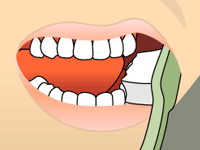
Brushing: Step 1
Place your toothbrush at a 45-degree angle to your gum.
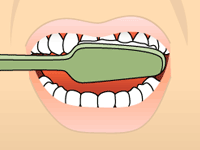
Brushing: Step 2
Brush gently in a circular motion.
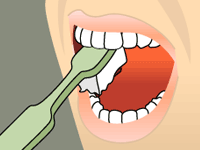
Brushing: Step 3
Brush the outer, inner, and chewing surfaces of each tooth.
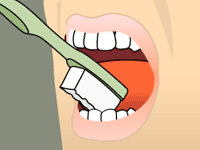
Brushing: Step 4
Use the tip of your brush for the inner surface of your front teeth.
- Flossing Instructions
-
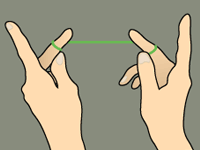
Flossing: Step 1
Wind about 18 inches of floss around your fingers as shown. Most of it should be wrapped around one finger, and the other finger takes it up as the floss is used.
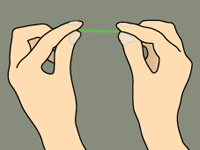
Flossing: Step 2
Use your thumbs and forefingers to guide about one inch of floss between your teeth.
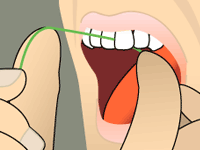
Flossing: Step 3
Holding the floss tightly, gently saw it between your teeth. Then curve the floss into a C-shape against one tooth and gently slide it beneath your gums.
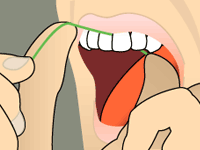
Flossing: Step 4
Slide the floss up and down, repeating for each tooth.
If it’s been six months or more since your child’s last dental checkup, then it’s time to contact our practice and schedule an appointment!
Fluoride
Your child brushes twice a day, flosses regularly, and visits the dentist every six months. But did you know that rinsing with fluoride – a mineral that helps prevent cavities and tooth decay – also helps keep teeth healthy and strong?
Fluoride is effective in preventing cavities and tooth decay by coating teeth and preventing plaque from building up and hardening on the tooth’s surface.
Fluoride comes in two varieties, systemic and topical:
- Systemic fluoride is ingested, usually through a public water supply. While teeth are forming under the gums, the fluoride strengthens tooth enamel, making it stronger and more resistant to cavities.
- Fluoride can also be applied topically to help prevent caries (cavities) on teeth present in the mouth. It is delivered through toothpaste, mouthwash, and professional fluoride applications. Professional application of topical fluoride foam and varnishes is also a valuable tool in cavity prevention.
Receiving a fluoride treatment from your dentist
A fluoride treatment in the dentist’s office takes just a few minutes. After the treatment, patients may be asked to not rinse, eat, or drink for at least 30 minutes in order to allow the teeth to absorb the fluoride. Depending on your child’s oral health or your doctor’s recommendation, your child may be required to have a fluoride treatment every three, six, or 12 months. Your doctor may also prescribe at-home fluoride products such as mouthwash, gels, or antibacterial rinses.
How to choose the right fluoride treatment
When choosing an at-home fluoride product (such as toothpaste or mouthwash), always check for the American Dental Association’s (ADA) seal of acceptance. Products marked with the ADA seal of approval have been carefully examined and approved by the ADA based on safety and effectiveness.
Sealants
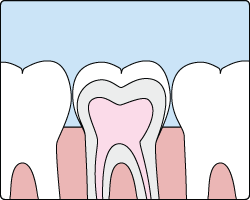
Sometimes brushing is not enough, especially when it comes to those hard-to-reach spots in your child’s mouth. It is difficult for a toothbrush to reach between the small cracks and grooves on teeth. If left alone, those tiny areas can develop tooth decay. Sealants give your child’s teeth extra protection against decay and help prevent cavities.
Dental sealants are plastic resins that bond and harden in the deep grooves on the tooth’s surface. When a tooth is sealed, the tiny grooves become smooth, and are less likely to harbor plaque. With sealants, brushing becomes easier and more effective against tooth decay.
Sealants are typically applied to children’s teeth after their permanent teeth have erupted as a preventive measure against tooth decay. It is more common to seal “permanent” teeth rather than “baby” teeth, but every patient has unique needs, and the dentist will recommend sealants on a case-by-case basis.
Sealants last from three to five years, although it is fairly common to see adults with sealants still intact from childhood. A dental sealant only provides protection when it is fully intact so if your child’s sealants come off, let the dentist know, and schedule an appointment for your child’s teeth to be re-sealed.
Digital X-rays
Using the most advanced dental technology possible is just as important as staying up to date on the latest treatment techniques. Because our practice is dedicated to providing your child with the safest and most convenient treatment options available, we utilize advanced digital X-ray technology in our office.
Is a digital X-ray really safer?
Because we care about your child’s bodily health and well-being, we believe that reducing the amount of radiation exposure is extremely important. Although the amount of radiation used in dental X-rays is very small, the effect is cumulative, so all radiation counts. Digital X-rays can reduce your child’s exposure to radiation by up to 80 percent!
What are the advantages of digital X-rays?
- We want your little one to be as comfortable as possible during their appointment, and digital X-rays eliminate the need to bite down on a sharp piece of film encased in plastic.
- There is no need to wait for the X-ray film to be developed before it can be viewed, so the entire checkup can be a lot shorter.
- The digital images can be enlarged and manipulated, giving the doctor a clear, more detailed look at your child’s teeth.
- Because your child can see the image enlarged on a screen, they can better understand why taking care of her teeth is important.
- It’s better for the earth! There is no need to use harmful chemicals to process film.
Our practice is focused on making your child’s dental experience as comfortable as possible. At your next appointment, we’ll be happy to answer any questions you may have.
